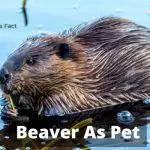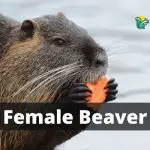What Would Happen if Beavers Went Extinct? The Most Underrated Animal In North America
Beavers are known for their dams, and in some parts of North America, their dams are big. They build dams and lodges and are the third-largest rodent in North America, But what would happen if beavers went extinct?

Beaver provided food for humans, too. As beavers cut down trees and dammed rivers and creeks to form lakes and ponds, they attracted other animals like otters, fish, and geese. If Beavers go extinct, we will miss many of the benefits these woodland creatures provide us.
There are multiple benefits we will miss out on if beavers go extinct. This guide will inform you about the circumstances if beavers went extinct.
Are Beavers Endangered?
Yes, beavers are endangered. An estimated 100,000 beavers remain in the wild and are threatened by habitat loss and hunting. The IUCN Red List of Threatened Species categorizes beavers as “least concern,” which means that their populations are not currently in danger of extinction.

Like Beavers, Capybaras experience suffering due to societal changes. Both past and present, they have had difficulty adjusting to their surroundings and have modified their way of life. Therefore, are capybaras in danger?
Things Will Happen if Beavers Went Extinct

If the beaver went extinct, there would be a lot of changes in the world. For one, the beaver’s dam-building abilities would be lost, leading to more flooding and erosion. Without the beaver, the populations of other animals that rely on them would also decline. The beaver is a keystone species, meaning their disappearance would have a ripple effect on the entire ecosystem.

Why Are Beavers a Keystone Species?
The beaver is a keystone species, meaning that its loss would have far-reaching consequences for the environment. Beavers are keystone predators, meaning their impact on the ecosystem is far-reaching. They play an essential role in controlling the populations of other animals, and their dams and lodges create habitats that organisms depend on for survival.

What Is Currently Being Done to Protect Beavers?
The Beaver Restoration Program is a collaborative effort between the BC Ministry of Forests, Lands and Natural Resource Operations, the BC Ministry of Environment, and the Government of Canada.
The program’s mission is to protect and restore beavers in British Columbia. We do this by managing their populations, monitoring their populations and habitats, and working with other organizations to reduce threats to their survival.
This video shows how beaver eats trees:
Why Do Beavers Build Dams?
The reasons why beavers build dams are many. Beavers use them to live, mate, raise their families, and store food. They help control the water levels of a pond and can create a habitat for fish and other aquatic creatures. Beavers like to build them in areas with a stream or brook to provide easy access to water and trees to make their homes.
Squirrel males and females differ in several ways. During the mating season, male squirrels’ testicles enlarge and become noticeable. Are you still unsure? Read our guide, “How to identify a male or female squirrel?”

Frequently Asked Question
How many beavers are left in the world in 2022?
There is much speculation about how many beavers are left in the world. Some experts say there could be as few as 100,000 beavers in the wild, while others believe there could be as many as two million. The truth probably lies somewhere in between these two estimates.
What is currently being done to protect beavers?
One thing that is being done is that beavers are being monitored to ensure harmful actions are not impacting them.

How Do Beavers Build Dams?
Beavers use trees to build the dam. The giant trees they can find near the stream. The beavers then use the trees to create the dam; they rub their bodies against the trees to get their scent. They then urinate on the trees and rub their bodies on them. The beavers make the dam to create a pond.
Final Words
Beavers are very helpful to the ecosystem. And we are seeing that number of these animals is decreasing. Now you have an idea of what would happen if beavers went extinct.
As beavers declined, other large mammals such as elephants, hippos, and bears rose. Due to the decreasing beaver population, different habitats with declining populations were filled. For example, beavers helped to keep ecosystems in balance.
If beavers went extinct, ecosystems would be less balanced, which could have a much more enormous and irreversible impact.




